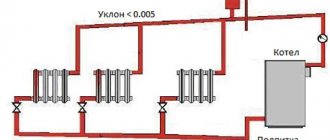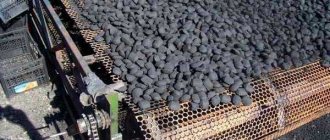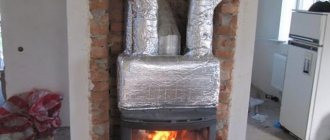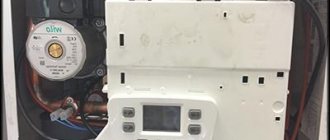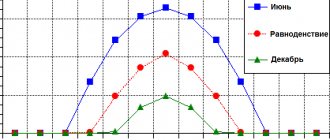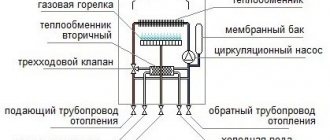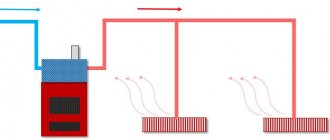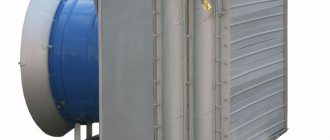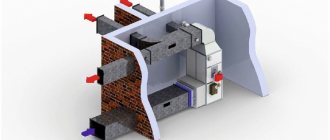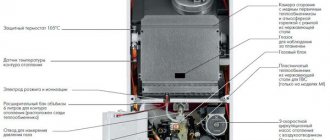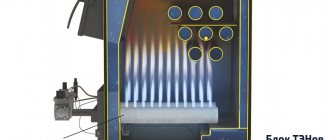Agree that heating a large room using a mini-boiler room is very problematic and expensive. An excellent solution would be gas heat generators for air heating. These are boilers that use gas burning in a chamber as energy to heat the coolant.
The power of the unit allows you to heat a building with an area of up to 70 sq.m. in 10-15 minutes without wiring and batteries. The equipment does not have the disadvantages inherent in traditional coolants: heat loss during transportation, inertia, difficulties in adjustment, the possibility of leaks, regular repairs.
In this article we will look at the design of gas-fired thermal energy generators. We will analyze their advantages and disadvantages, and also help you choose the best heating device. Taking into account our recommendations, you will easily find a suitable unit.
Design features of gas heat generators
Air heating is most effective in exhibition halls, production facilities, film studios, car washes, poultry farms, workshops, large private homes, etc.
A standard gas heat generator for air heating consists of several parts that interact with each other:
- Frame . All components of the generator are hidden in it. In its lower part there is an inlet opening, and at the top there is a nozzle for already heated air.
- The combustion chamber . This is where fuel is burned, causing the coolant to heat up. It is located above the supply fan.
- Burner . The device supplies compressed oxygen to the combustion chamber. Thanks to this, the combustion process is supported.
- Fan . It distributes heated air throughout the room. It is located behind the inlet grille in the lower part of the housing.
- Metal heat exchanger . A compartment from which heated air is supplied to the outside. It is located above the combustion chamber.
- Hoods and filters . Limit the entry of flammable gases into the room.
Air is supplied to the housing via a fan. Vacuum is generated in the area of the supply grille.
An air heating device costs 3-4 times less than a “water” circuit. In addition, air options are not at risk of loss of thermal energy during transportation due to hydraulic resistance
The pressure is concentrated opposite the combustion chamber. By oxidizing liquefied or natural gas, the burner generates heat.
The energy from the combustion gas is absorbed by a metal heat exchanger. As a result, air circulation in the case becomes more difficult, its speed is lost, but the temperature rises.
Knowing the power of the heating element, you can calculate the size of the hole that will provide the necessary air flow
Without a heat exchanger, most of the energy from the combustion gas would be wasted and the burner efficiency would be lower.
Such heat exchange heats the air to 40-60°C, after which it is supplied to the room through a nozzle or socket, which is provided in the upper part of the housing.
Fuel is supplied to the combustion chamber, where during the combustion process the heat exchanger is heated, transferring thermal energy to the coolant
The environmental friendliness of the equipment, as well as its safety, make it possible to use heat generators in everyday life. Another advantage is the absence of liquid moving through pipes to convectors (batteries). The heat generated warms the air, not the water. Thanks to this, the efficiency of the device reaches 95%.
Heat generator in heating
Maintaining a certain temperature regime in industrial premises, especially in winter, is quite difficult if a heating system .
Heating a large area or installing stationary heating that receives heat from a mini-boiler room is too expensive and cumbersome. Therefore, many people, including owners of country houses with large square footage, resort to the help of heat generators.
A heat generator is a device that has a complex internal structure and produces heat, which, with the help of a fan, is distributed with air flow throughout the entire area . This unit is quite powerful, capable of heating an area to a comfortable temperature of 60-70 sq.m. in just 10-15 minutes. The only difficulty that accompanies all owners of heat generators is the cost of both the unit itself and the consumed fuel on which it operates. Otherwise, the device shows only its positive sides, allowing you to heat quickly, a lot and with high quality.
The video is about a solid fuel stove heat generator
Structure and design features
The heat generator consists of such structural parts as:
- Combustion chamber – this is where the process of fuel combustion and heating of the coolant takes place.
- Burner - supplies compressed oxygen to the combustion chamber to support the combustion process.
- Fan – ensures the distribution of heated air in a spatial room.
- Heat exchanger is a chamber from which heated air comes out.
- Filters and hoods prevent flammable gases from entering the air of a heated area.
The type and design of the burner directly depends on what kind of fuel is used (liquid, solid or gaseous). If desired, the burner can be replaced with your own hands, and the entire system is adjusted to the type of fuel that the customer desires.
The main advantage and feature of the design is the fact that the chambers and compartments of the heat generator are located in such a way that the spent fuel (more precisely, its decay products) does not mix with the air that circulates in the room.
This is very important because spent fuel is a toxic gas that can cause asphyxiation to people living in heated areas. A high level of safety, as well as environmental friendliness, allows the use of heat generators not only in industry, but also in everyday life.
Another advantage is the absence of an intermediate coolant that would require additional heating (pipes, batteries, coils, etc.). That is, the heat generated from fuel combustion is completely spent on heating the air, and is not spent on heating the coolant. This allows you to increase efficiency up to 95%, and the result is felt immediately after the heat generator starts working.
One example of an air heat generator, manufacturer Robust
Operating principle of the heating system
Fuel is supplied to the combustion chamber, where the heat exchanger heats up during the combustion process.
The fan uses its blades to capture air in the room and passes it through the heat exchanger. Heated air circulates throughout the room, performing several cycles. The operating principle is quite simple and has many advantages. You should not be afraid that during operation the pipe will burst and the neighbors below will end up in the water, and you will be in an unpleasant situation, which, moreover, will hit your pocket. The device is completely safe and also has automatic sensors that stop fuel combustion when there are threats of breakdown or emergency situations.
Air heated in the heat generator can be supplied to the room in two ways :
- Directly from the fan - heated air circulates and also replaces cold air, regulating and maintaining the temperature. This type of heating system is only convenient if the heated areas are not large.
- Through a system of interconnected air ducts, heated air (using artificial ventilation) circulates through the air ducts, heating several rooms at once from one generator. It is used for heating large pavilions and utility rooms with many separate rooms.
The generator itself can be installed both directly indoors and outside, on the street. The type of heat generator, which has an additional protection system from the influence of weather conditions (high humidity, frosty weather, snow cover), will depend on this indicator.
The key condition for the full functioning of a heating system using a heat generator is the correct connection of the exhaust pipe to the chimney, as well as the presence of draft from the latter. If the chimney is clogged, it is important to clear it of accumulated soot before installing the system. Otherwise, toxic substances may enter the heated room, causing poisoning.
The video shows the operation of the Totem solid fuel heat generator
Types of heat generators
A person’s heating needs determine the type of generator, of which there are a huge number today.
They are differentiated not only by the fuel used, but also by other parameters:
- By dimensions and weight:
- mobile – easy to transport;
- stationary - used only in a certain place, there are two types: hanging - can be used both indoors and outdoors;
- floor - used only indoors.
- According to the method of fuel combustion and distribution of heated air:
- horizontal – air exchange occurs in a horizontal projection, convenient when a small room is heated;
- vertical - heated air circulates from bottom to top, providing heating for rooms with high ceilings.
- By type of fuel burned:
- gas - the most common and cheapest type of fuel, allowing significant savings on heating (high heat transfer during combustion);
- diesel - they run on diesel fuel, but require annual cleaning and maintenance, as combustion products pollute the unit;
- vortex - the operating principle is based on complex physical processes that make it possible to obtain energy from water;
- universal - can work on both liquid and solid fuels, as well as on wood, vegetable oil, manure, peat and coal.
The choice of fuel directly depends on factors such as:
- intensity and speed of air heating;
- the amount of fuel consumed and heating costs in monetary terms;
- the cost of the equipment and its service life (solid fuel ones become clogged faster and also require manual removal of fuel residues).
How does the heating system work?
The fan blades capture air and direct it to the heat exchanger. The air flow heated by it circulates throughout the building, performing several cycles.
The main advantage of the gas heat generator design is that the arrangement of the chambers and compartments prevents the mixing of spent fuel decay products with the air from the room
While operating the equipment, there is no need to worry that a pipe will burst and you will flood your neighbors, as often happens with water heating systems. However, the heat-generating device itself contains sensors that, in emergency situations (threat of breakdown), stop the fuel supply.
Heated air is supplied to the room in several ways:
- Ductless. Warm air flows freely into the space being processed. During circulation, it replaces the cold one, which allows you to maintain the temperature regime. The use of this type of heating is advisable in small rooms.
- Duct. Through a system of interconnected air ducts, heated air moves through the air ducts, making it possible to heat several rooms at the same time. Used for heating large buildings with separate rooms.
The movement of the air mass is stimulated by a fan or gravity. The heat generator can be installed indoors and outdoors.
Using air as a coolant makes the system as profitable as possible. The air mass does not cause corrosion and is also not capable of damaging any elements of the system
In order for the heating system to function correctly, the chimney must be correctly connected to the gas thermal energy generator.
If the smoke duct is installed incorrectly, it will become more likely to become clogged with soot build-up. A narrowed and clogged chimney will poorly remove toxic substances.
Air heating systems for industrial premises
The air heating system for an industrial premises does not differ significantly from a similar method of heating a private home. The same air heaters, heat generators, and fans can be used. The only difference is the large size of the premises, which require appropriate equipment capacity.
When designing heating systems for industrial premises, an important point is compliance with fire safety standards and regulations. Depending on the operational characteristics of production areas, the placement of gas heat generators may be prohibited. In such cases, they are taken outside the premises. Diesel generators are actively used for air heating of production facilities. They are distinguished by their high power, allowing the installation of branched air duct systems.
A special indicator when designing an air heating system is the height of the ceilings. Warm air should be directed to the desired area of the room. Fan heaters cope best with this task. Using these units for heating has the following advantages:
- quick, inexpensive installation (fan heaters are mounted on walls or ceilings), it can be performed by company employees;
- there is no need to lay heating mains and air ducts, therefore, small capital investments will be required;
- the ability to direct warm air flow to the desired area;
- does not require constant monitoring and maintenance;
- low noise level, which is relevant for many types of production.
When designing a heating system for an industrial premises, it is important to comply with fire safety standards.
Air heating by ventilation is characterized by a minimal level of heat loss and energy consumption. In addition to heating, it is also used for drying wood and other materials on an industrial scale. Heat guns are also used to heat industrial premises. Such devices are connected to a voltage of 380 W. The heated air is released in a targeted, long-range, powerful stream.
Advantages and disadvantages of equipment
The popularity of gas heat generators is associated with a number of advantages:
- gas is the most accessible and inexpensive type of fuel;
- the device does not heat the coolant, but the air, which makes it economical and safe;
- Efficiency is 95%, which allows you to heat a large room within an hour;
- thanks to the air duct system, you can independently regulate the volume of the heated area;
- ability to move the device;
- all processes are automated, as a result of which any user can control the system and manage its operation;
- the device is also used for ventilation and air conditioning of the building;
- in some models you can change burners for liquefied and natural gas;
- there is no need to install a pipe system and install heating radiators, as a result, the cost of the system is reduced;
- the heat generator can be installed outside the heated building;
- simplicity and speed of installation.
Some consumers are put off by the high cost of the equipment, but the system pays for itself within one year.
The air heating system has one drawback - rapid heat loss. The presence of temperature sensors in the gas heat generator allows it to be automatically started to maintain a comfortable temperature without human intervention
Minor disadvantages are also the need to obtain permits for connecting gas equipment and installing a chimney.
Types of gas heat generators
Compared to diesel, solid fuel and universal heat generators, gas equipment for air heating is the most popular.
Devices are differentiated by size and weight:
- mobile - easy to transport;
- stationary - installed in one place.
Mobile models of gas heat generators are less popular, since their operation requires gas cylinders filled with liquefied mixtures of propane and butane. The most striking representative of portable heating equipment is a heat gun.
Most often, heat guns are used for a one-time increase in temperature at construction sites and in shopping malls. In everyday life it is used in extreme cases (turning off the heating in the house).
Stationary models of gas heat generators can be:
- wall-hung - hung on brackets built into the walls;
- floor - installed on the floor.
Wall-mounted models are used for heating small objects; their power usually does not exceed 35 kW. Floor-standing equipment is recommended for heating small areas. A number of floor-standing units include models that can be installed outside the building, i.e. on the street.
In order for atmospheric gas processing equipment to operate continuously, it is necessary to ensure a constant supply of air to the combustion chamber
Depending on the distribution of heated oxygen and the method of gas combustion, the equipment is divided into:
- horizontal;
- vertical.
For rooms with high ceilings, vertical devices are used, and for rooms with low ceilings, horizontal devices are used.
Types of heat generators
All existing heating generators can be divided into two types:
- Mobile devices can be either compact or have quite impressive dimensions. The latter can be moved on trolleys specially mounted for them.
They are called “mobile” for the reason that they are not connected to a gas pipeline, but are powered by gas cylinders, and accordingly, they can be installed anywhere. Most often, such devices are used to heat production workshops. It should be noted that devices of this type especially require effective ventilation, since heated air is removed with combustion products.
Hanging stationary device
- Stationary - connected to the gas pipeline.
These devices, in turn, are divided into two types:
- Suspended - designed, as a rule, for heating one room. Such devices are most popular in country houses, as they do not take up useful space, quickly warm up the room, and the instructions for installing them are extremely simple.
- Floor-standing - are more bulky devices that are designed to heat large rooms or the entire house. Most models allow you to connect an air duct system to them to distribute heat evenly throughout all rooms of the house.
Floor-standing gas heat generator
Of course, to ensure efficient gas-air heating, you need to choose the right not only the type of heater, but also its power. It is better to entrust the calculation of the heating system to specialists, or use special formulas that can be found on our portal.
Advice! In order for a gas air heating furnace to work as expected, it is necessary to ensure a constant flow of fresh air into the room. For this purpose, a ventilation system is used, which not only provides an influx of oxygen, but also removes carbon dioxide with excess combustion to the outside.
Here, perhaps, are all the main types and features of gas-air heat generators that you need to know if you decide to equip the heating system in your house in this way.
How to choose a heat generator?
When choosing heating equipment, you need to take into account a lot of details. First of all, it is important to assess the area of the heated room. The larger the building, the more powerful the heat generator should be.
The heat capacity of a building is calculated using the formula:
р=V·ΔT·k/860
p is the desired heat capacity;
V - heated area (the height, length and width of the room are multiplied);
ΔT is the difference in temperature in the building and outside it;
K - thermal insulation (indicators of the material with which the building is insulated).
Indicators of the most commonly used materials:
- double layer of brick - 1-1.9 W/m°C;
- single layer of brick - 2-2.9 W/m°C;
- wooden panels or corrugated sheets - 3-4 W/m°C;
- modern heat and waterproofing - 0.6-0.9 W/m°C.
The indicator for the number of kilocalories in kilowatts is 860. Generally accepted standards - for 1 kW of heat generator power, 30 cubic meters of forced air are required.
The power of the air heater must exceed the power of the burner by at least 15%. Such equipment is reliable and effective in any situation. Its use reduces energy costs
Knowing the value of heat capacity, you can select equipment that can heat the entire area of the room.
Nuances when choosing a heat generator
Before purchasing heating equipment, you must:
- arrange a chimney to release toxic gases;
- think over a system of ventilation ducts for circulating heated air;
- Using the formula, calculate the power of the device.
Having completed all these steps, you can safely go shopping.
If there are problems with ventilation in the room, it is recommended to install a powerful floor-standing generator and synchronize its operation with ventilation that takes air directly from the street
To select a high-quality gas heat generator model, you need to pay attention to the following nuances:
- type and design of the burner - relevant if a fuel change may be required;
- warranty card and technical passport - a guarantee of the purchase of original (not defective) equipment;
- high-quality components - such equipment is more expensive, but its service life is much longer.
Taking these factors into account, the selected heat generator will last for many years.
Tips for choosing reliable equipment
By following simple recommendations you can avoid purchasing low-quality goods:
- It is better to make purchases at certified points of sale. Often, at wholesale stores and on the Internet, defective products are sold under the guise of high-quality equipment. The trap is the price halved.
- If it is not possible or you did not have time to calculate the required power of the device, then the consultants in the store will do this for you. To do this, you only need to know the area of the house, the height of the ceilings and the thickness of the walls. After making calculations, specialists will offer the optimal model for your home.
- It is recommended to purchase brands that have positive reviews on the Internet. You can also find out in advance how the equipment behaves during operation and other features.
For home use, the ideal option would be models such as Airmax D 28, Titan 25 (30, 35), Fuela, TG-7.5, Dragon 12.
Requirements for installation
To connect a gas heat generator for air heating at home, you need to carry out preparatory work and purchase:
- flexible air duct, which is a galvanized tube for circulating heated air;
- tees are needed to create an air line and connect pipes;
- for taking in cold air and supplying hot air - a grille;
- to seal the line connections - aluminum tape;
- mounting fasteners;
- knife.
You should first take care of the air duct.
You can install a gas heat generator with your own hands, but it must be connected to the gas pipeline by representatives of the gas service, with which an agreement has been concluded for the supply of blue fuel and maintenance of equipment
The ideal option is to design airways - channels at the construction stage of the building.
To install heating in a finished house, you need to erect false walls and suspended ceilings. Pipes will be disguised in the resulting niches.
